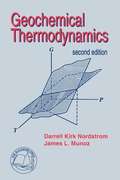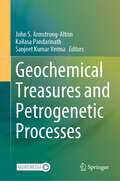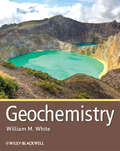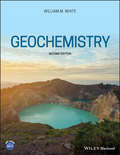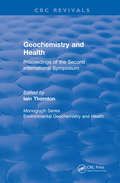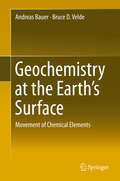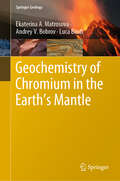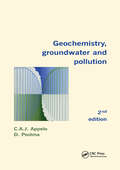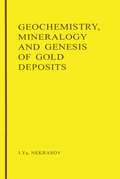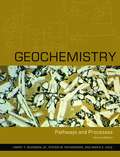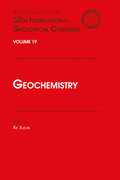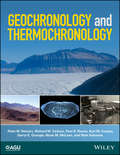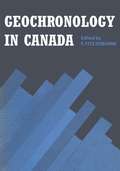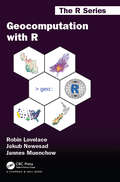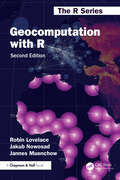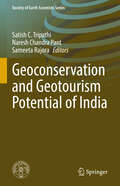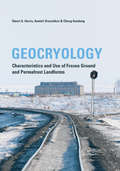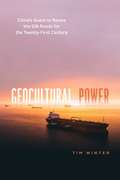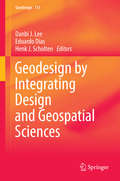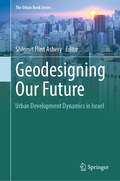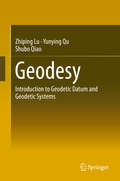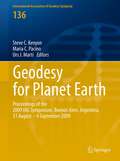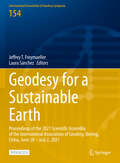- Table View
- List View
Geochemical Thermodynamics
by Darrell Kirk Nordstron James L. MunozGeochemical Thermodynamics (Second Edition), first published in 1994, takes the reader beyond the fundamental principles of thermodynamics to true geochemical applications. You will find the most complete coverage of the phase rule, chemography, solid solutions, ionic activities in the mixed aqueous electrolytes, and chemical potential diagrams for multiphase systems, plus other concepts central to geochemical theory. Throughout, there is an emphasis on environmentally relevant examples and applications. New sections include: - thermobarometry applications for igneous and metamorphic rocks; -expanding information on electrolytes at high temperature and pressure; - a new chapter on geochemical modeling; and substantially updated and expanded references. - a new appendix containing internally consistent enthalpies, entropies, heat capacities, and free energies, and equilibrium constants for a limited number of elements, ions, non-silicate minerals, and reactions at 298. 15K and 1 atmosphere that are particularly useful for hydrogeochemical modeling. 'This book presents the thermodynamics of geochemical systems, with applications ranging from groundwater to magmas. It should be of interest to a large number of such scientists wishing better acquaintance with the application of thermodynamics to practical problems. Geology There is a good balance of theory and application, and the book is superior to any other available text at the graduate or undergraduate level I can strongly recommend this book, having used it for a third-year undergraduate geochemistry course. It is most appropriate for physical geochemistry course with an emphases on thermodynamics. Researchers in petrology oriented fields will also find the book useful Canadian Mineralogist
Geochemical Treasures and Petrogenetic Processes
by John S. Armstrong-Altrin Kailasa Pandarinath Sanjeet Kumar VermaThis book highlights various aspects of geochemical and geological processes. In brief, it facilitates to understand the geochemical behavior of major, trace and rare earth elements in rocks to identify the magmatic processes involved in present-day magma generation and their relation to global tectonic regimes as well as geothermal studies. Therefore, the book provides a comprehensive view of the generation of magma types (mafic to felsic in composition) and their role in the petrogenesis. The book also covers the development of new geosoftware to effectively process the geochemical data before its interpretation.
Geochemistry
by Francis AlbarèdeIntroducing the essentials of modern geochemistry for students across the Earth and environmental sciences, this new edition emphasises the general principles of this central discipline. Focusing on inorganic chemistry, Francis AlbarÉde's refreshing approach is brought to topics that range from measuring geological time to the understanding of climate change. The author leads the student through the necessary mathematics to understand the quantitative aspects of the subject in an easily understandable manner. The early chapters cover the principles and methods of physics and chemistry that underlie geochemistry, to build the students' understanding of concepts such as isotopes, fractionation, and mixing. These are then applied across many of the environments on Earth, including the solid Earth, rivers, and climate, and then extended to processes on other planets. Three new chapters have been added – on stable isotopes, biogeochemistry, and environmental geochemistry. End-of-chapter student exercises, with solutions available online, are also included.
Geochemistry
by William M. WhiteThis book provides a comprehensive introduction to the field of geochemistry. The book first lays out the 'geochemical toolbox': the basic principles and techniques of modern geochemistry, beginning with a review of thermodynamics and kinetics as they apply to the Earth and its environs. These basic concepts are then applied to understanding processes in aqueous systems and the behavior of trace elements in magmatic systems. Subsequent chapters introduce radiogenic and stable isotope geochemistry and illustrate their application to such diverse topics as determining geologic time, ancient climates, and the diets of prehistoric peoples. The focus then broadens to the formation of the solar system, the Earth, and the elements themselves. Then the composition of the Earth itself becomes the topic, examining the composition of the core, the mantle, and the crust and exploring how this structure originated. A final chapter covers organic chemistry, including the origin of fossil fuels and the carbon cycle's role in controlling Earth's climate, both in the geologic past and the rapidly changing present.Geochemistry is essential reading for all earth science students, as well as for researchers and applied scientists who require an introduction to the essential theory of geochemistry, and a survey of its applications in the earth and environmental sciences.Additional resources can be found at: www.wiley.com/go/white/geochemistry
Geochemistry (Wiley Works)
by William M. WhiteA Comprehensive Introduction to the “Geochemist Toolbox” – the Basic Principles of Modern Geochemistry In the new edition of William M. White’s Geochemistry, undergraduate and graduate students will find each of the core principles of geochemistry covered. From defining key principles and methods to examining Earth’s core composition and exploring organic chemistry and fossil fuels, this definitive edition encompasses all the information needed for a solid foundation in the earth sciences for beginners and beyond. For researchers and applied scientists, this book will act as a useful reference on fundamental theories of geochemistry, applications, and environmental sciences. The new edition includes new chapters on the geochemistry of the Earth’s surface (the “critical zone”), marine geochemistry, and applied geochemistry as it relates to environmental applications and geochemical exploration. ● A review of the fundamentals of geochemical thermodynamics and kinetics, trace element and organic geochemistry ● An introduction to radiogenic and stable isotope geochemistry and applications such as geologic time, ancient climates, and diets of prehistoric people ● Formation of the Earth and composition and origins of the core, the mantle, and the crust ● New chapters that cover soils and streams, the oceans, and geochemistry applied to the environment and mineral exploration In this foundational look at geochemistry, new learners and professionals will find the answer to the essential principles and techniques of the science behind the Earth and its environs.
Geochemistry and Health: Proceedings of the Second International Symposium (CRC Press Revivals)
by J.N. MartinThis volume comprises the proceedings of a three-day meeting held at the Royal Society, London, UK on 22,23,24 April 1987. The combined second International Symposium on Geochemistry and Health and 5th European Meeting of the Society for Environmental Geochemistry and Health was sponsored by the International Association of Geochemistry and Cosmochemistry, UMESCO, the Society for Environmental Geochemistry and Health and Imperial College with additional finacial supposrt from the UK Department of the Environment, the Royal Society, London and the Southern California Edison Company.
Geochemistry at the Earth's Surface
by Andreas Bauer Bruce D. VeldeGeochemistry at the surface of the earth is dominated by two somewhat antagonistic forces: chemical reactions which attempt to attain a steady state (equilibrium) and geological movement of materials in time and space which changes the parameters that control chemical equilibrium. Another aspect that is extremely important to earth surface geochemistry is the effect of plants on the chemical and physical stability of materials (soils). Plant systems in fact work against the normal chemical changes (loss of silica, potassium, etc. ) and the normal physical changes (stabilizing fine grained materials (clays) in the surface zones to avoid erosion). Biological effects are clearly seen in redox effects in the various parts of the earth surface movement cycle; soil formation, stream transport, sedimentation. This book attempts to outline these different parameters and their interactions as they affect earth surface geochemistry in order to give a better understanding of movement and accumulation of elements at the surface of the earth.
Geochemistry of Chromium in the Earth’s Mantle (Springer Geology)
by Ekaterina A. Matrosova Andrey V. Bobrov Luca BindiThis book provides an analysis of an actual problem of the evolution of deep matter under the conditions of the upper mantle, transition zone, and uppermost lower mantle. This issue has a fundamental importance in geochemistry, petrology, mineralogy, and crystalochemistry of the mantle, at different depths. The authors discuss new experimental research on the composition and conditions of the chromium-bearing minerals genesis and their associations in the Earth’s mantle. The experimental data are compared with the natural mineral assemblages, allowing a refinement of the structure and composition of the deep Geospheres of the Earth. The results of the physicochemical experiments in the "MgO–SiO2–Cr2O3" model and the multicomponent systems play a major role in understanding the phase diagrams of these systems, the structural patterns of chromium-bearing phases and the influence of Cr on P-T parameters in the Earth’s mantle.
Geochemistry, Groundwater and Pollution
by Dieke Postma C.A.J. AppeloBuilding on the success of its 1993 predecessor, this second edition of Geochemistry, Groundwater and Pollution has been thoroughly re-written, updated and extended to provide a complete and authoritative account of modern hydrogeochemistry.Offering a quantitative approach to the study of groundwater quality and the interaction of water, minerals,
Geochemistry, Mineralogy and Genesis of Gold Deposits
by I.Y. NekrasovThe behaviour of gold in sedimentary, magmatic and postmagmatic processes are studied and 40 gold-bearing minerals including ten which were recently discovered are described. The results are presented of new experimental studies on phase relations in gold-sulphide systems. The solubility & form of gold migration in high-temperature chloride, sulphide and arsenic solutions are determined. Based on the new data, the genesis of gold deposits is studied and a geochemical classification proposed. This book is designed for specialists in the field of gold chemistry, geochemistry and mineralogy and for field geologists surveying and prospecting for gold.
Geochemistry: Pathways and Processes
by Maria Uhle Harry McSween Steven RichardsonWritten expressly for undergraduate and graduate geologists, this book focuses on how geochemical principles can be used to solve practical problems. The attention to problem-solving reflects the authors'belief that showing how theory is useful in solving real-life problems is vital for learning. The book gives students a thorough grasp of the basic principles of the subject, balancing the traditional equilibrium perspective and the kinetic viewpoint. The first half of the book considers processes in which temperature and pressure are nearly constant. After introductions to the laws of thermodynamics, to fundamental equations for flow and diffusion, and to solution chemistry, these principles are used to investigate diagenesis, weathering, and natural waters. The second half of the book applies thermodynamics and kinetics to systems undergoing changes in temperature and pressure during magmatism and metamorphism. This revised edition incorporates new geochemical discoveries as examples of processes and pathways, with new chapters on mineral structure and bonding and on organic matter and biomarkers. Each chapter has worked problems, and the authors assume that the student has had a year of college-level chemistry and a year of calculus.Praise for the first edition"A truly modern geochemistry book.... Very well written and quite enjoyable to read.... An excellent basic text for graduate level instruction in geochemistry." —Journal of Geological Education"An up-to-date, broadly conceived introduction to geochemistry.... Given the recent flowering of geochemistry as an interdisciplinary science, and given the extent to which it now draws upon the fundamentals of thermodynamics and kinetics to understand earth and planetary processes, this timely and rigorous [book] is welcome indeed." —Geochimica et Cosmochimica Acta
Geochemistry: Pathways and Processes, Second Edition
by Mcsween Harry Y. Steven M. Richardson Maria UhleWritten expressly for undergraduate and graduate geologists, this book focuses on how geochemical principles can be used to solve practical problems. The attention to problem-solving reflects the authors' belief that showing how theory is useful in solving real-life problems is vital for learning. The book gives students a thorough grasp of the basic principles of the subject, balancing the traditional equilibrium perspective and the kinetic viewpoint.
Geochemistry: Proceedings of the 30th International Geological Congress, Volume 19
by Xie XuejinThis book is a collection of papers presented in the 30th International Geological Congress, held in Beijing, on geochemistry. The papers deal with topics on fluid-rock interaction, geochemical kinetics, geochemical mapping, environmental geochemistry, and exploration geochemistry.
Geochronology and Thermochronology (Wiley Works)
by Peter W. Reiners Richard W. Carlson Paul R. Renne Kari M. Cooper Darryl E. Granger Noah M. McLean Blair SchoeneThis book is a welcome introduction and reference for users and innovators in geochronology. It provides modern perspectives on the current state-of-the art in most of the principal areas of geochronology and thermochronology, while recognizing that they are changing at a fast pace. It emphasizes fundamentals and systematics, historical perspective, analytical methods, data interpretation, and some applications chosen from the literature. This book complements existing coverage by expanding on those parts of isotope geochemistry that are concerned with dates and rates and insights into Earth and planetary science that come from temporal perspectives. Geochronology and Thermochronology offers chapters covering: Foundations of Radioisotopic Dating; Analytical Methods; Interpretational Approaches: Making Sense of Data; Diffusion and Thermochronologic Interpretations; Rb-Sr, Sm-Nd, Lu-Hf; Re-Os and Pt-Os; U-Th-Pb Geochronology and Thermochronology; The K-Ar and 40Ar/39Ar Systems; Radiation-damage Methods of Geo- and Thermochronology; The (U-Th)/He System; Uranium-series Geochronology; Cosmogenic Nuclides; and Extinct Radionuclide Chronology. Offers a foundation for understanding each of the methods and for illuminating directions that will be important in the near future Presents the fundamentals, perspectives, and opportunities in modern geochronology in a way that inspires further innovation, creative technique development, and applications Provides references to rapidly evolving topics that will enable readers to pursue future developments Geochronology and Thermochronology is designed for graduate and upper-level undergraduate students with a solid background in mathematics, geochemistry, and geology.Read an interview with the editors to find out more:https://eos.org/editors-vox/the-science-of-dates-and-rates
Geochronology in Canada (The Royal Society of Canada Special Publications #No. 8)
by Freleigh OsborneThis volume is made up of papers presented at a colloquium of the Geology Devision of Section III of the Royal Society of Canada at the annual meeting in Quebec, June 1963. The papers fall into two groups: in one group the validity and shortcomings of the methods of establishing the geographical time-table are discussed; and, in the other, applications of the methods to areas across Canada, and from Precambrian to recent, are described. The geological time-table has been built up from the record of the rocks and is based on the law of superposition, a fact that is pointed out in the first paper of this volume. The chronological value of fossils, palaeomagnetism as a means of dating geological events, the limitations of radiometric dating, and other pertinent matters are here dealth with by a group of well-known authorities. These scientific disquisitions will be of great importance to geologists everywhere.This work should be of special interest to those engaged in research on the history of the earth, particularly in relation to the nature, the causes, and the time of an event. It will also serve as a valuable reference to practising geologists in government or industry, to university departments of geology, and to geological consultants. Royal Society of Canada, "Special Publications" Series, no. 8.
Geocomputation with R (Chapman & Hall/CRC The R Series)
by Robin Lovelace Jakub Nowosad Jannes MuenchowGeocomputation with R is for people who want to analyze, visualize and model geographic data with open source software. It is based on R, a statistical programming language that has powerful data processing, visualization, and geospatial capabilities. The book equips you with the knowledge and skills to tackle a wide range of issues manifested in geographic data, including those with scientific, societal, and environmental implications. This book will interest people from many backgrounds, especially Geographic Information Systems (GIS) users interested in applying their domain-specific knowledge in a powerful open source language for data science, and R users interested in extending their skills to handle spatial data. The book is divided into three parts: (I) Foundations, aimed at getting you up-to-speed with geographic data in R, (II) extensions, which covers advanced techniques, and (III) applications to real-world problems. The chapters cover progressively more advanced topics, with early chapters providing strong foundations on which the later chapters build. Part I describes the nature of spatial datasets in R and methods for manipulating them. It also covers geographic data import/export and transforming coordinate reference systems. Part II represents methods that build on these foundations. It covers advanced map making (including web mapping), "bridges" to GIS, sharing reproducible code, and how to do cross-validation in the presence of spatial autocorrelation. Part III applies the knowledge gained to tackle real-world problems, including representing and modeling transport systems, finding optimal locations for stores or services, and ecological modeling. Exercises at the end of each chapter give you the skills needed to tackle a range of geospatial problems. Solutions for each chapter and supplementary materials providing extended examples are available at https://geocompr.github.io/geocompkg/articles/.
Geocomputation with R (Chapman & Hall/CRC The R Series)
by Robin Lovelace Jakub Nowosad Jannes MuenchowGeocomputation with R is for people who want to analyze, visualize, and model geographic data with open source software. The book provides a foundation for learning how to solve a wide range of geographic data analysis problems in a reproducible, and therefore scientifically sound and scalable way. The second edition features numerous updates, including the adoption of the high-performance terra package for all raster data processing, detailed coverage of the spherical geometry engine s2, updated information on coordinate reference systems and new content on openEO, STAC, COG, and gdalcubes. The data visualization chapter has been revamped around version 4 of the tmap package, providing a fresh perspective on creating publication-quality maps from the command line. The importance of the book is also highlighted in a new foreword by Edzer Pebesma.The book equips you with the knowledge and skills necessary to tackle a wide range of issues manifested in geographic data, including those with scientific, societal, and environmental implications. The book is especially well-suited to: Data scientists and engineers interested in upskilling to handle spatial data. People with existing geographic data skills interested in developing powerful geosolutions via code. Anyone who needs to work with spatial data in a reproducible and scalable way. The book is divided into three parts: Foundations, Extensions, and Applications, covering progressively more advanced topics. The exercises at the end of each chapter provide the necessary skills to address various geospatial problems, with solutions and supplementary materials available at r.geocompx.org/solutions/.
Geoconservation and Geotourism Potential of India (Society of Earth Scientists Series)
by Satish C. Tripathi Naresh Chandra Pant Sameeta RajoraIndia is blessed with great geological diversity as it has recorded more than 3.5 billion year’s history of evolution of Earth, some of the sites/sections are unique to the globe. The recent discovery of youngest ‘Meghalayan age’ from a limestone cave of Meghalaya is internationally recognised. The Indian rock record bears the signatures of various global geological events including evolution of life, mass extinction, making of Himalaya, meteoritic impact craters etc. Indian dinosaur 'Rajasaurus' created curiosity in the children. Interestingly, large number of geoheritage sites are associated with well-known cultural heritage sites and biodiversity hotspots. However, proper scientific details of geoheritage sites and their potential to develop as a geotourism hotspot has not been discussed. Geotourism potential of India in extensive but so far it has not attracted attention of authorities and agencies of the Tourism sector. The present book provides a platform for them to plan and explore. Development of geotourism will lead to conservation of geoheritage sites and both financial and scientific aspects will be covered.
Geocryology: Characteristics and Use of Frozen Ground and Permafrost Landforms
by Stuart A. Harris Anatoli Brouchkov Cheng GuodongThis book provides a general survey of Geocryology, which is the study of frozen ground called permafrost. Frozen ground is the product of cold climates as well as a variety of environmental factors. Its major characteristic is the accumulation of large quantities of ice which may exceed 90% by volume. Soil water changing to ice results in ground heaving, while thawing of this ice produces ground subsidence often accompanied by soil flowage. Permafrost is very susceptible to changes in weather and climate as well as to changes in the microenvironment. Cold weather produces contraction of the ground, resulting in cracking of the soil as well as breakup of concrete, rock, etc. Thus permafrost regions have unique landforms and processes not found in warmer lands. The book is divided into three parts. Part 1 provides an introduction to the characteristics of permafrost. Four chapters deal with its definition and characteristics, the unique processes operating there, the factors affecting it, and its general distribution. Part 2 consists of seven chapters describing the characteristic landforms unique to these areas and the processes involved in their formation. Part 3 discusses the special problems encountered by engineers in construction projects including settlements, roads and railways, the oil and gas industry, mining, and the agricultural and forest industries. The three authors represent three countries and three language groups, and together have over 120 years of experience of working in permafrost areas throughout the world. The book contains over 300 illustrations and photographs, and includes an extensive bibliography in order to introduce the interested reader to the large current literature. Finalist of the 2019 PROSE Awards.
Geocultural Power: China's Quest to Revive the Silk Roads for the Twenty-First Century (Silk Roads)
by Tim WinterLaunched in 2013, China's Belt and Road Initiative is forging connections in infrastructure, trade, energy, finance, tourism, and culture across Eurasia and Africa. This extraordinarily ambitious strategy places China at the center of a geography of overland and maritime connectivity stretching across more than sixty countries and incorporating almost two-thirds of the world’s population. But what does it mean to revive the Silk Roads for the twenty-first century? Geocultural Power explores this question by considering how China is couching its strategy for building trade, foreign relations, and energy and political security in an evocative topography of history. Until now Belt and Road has been discussed as a geopolitical and geoeconomic project. This book introduces geocultural power to the analysis of international affairs. Tim Winter highlights how many countries—including Iran, Sri Lanka, Kenya, Malaysia, Indonesia, Pakistan, and others—are revisiting their histories to find points of diplomatic and cultural connection. Through the revived Silk Roads, China becomes the new author of Eurasian history and the architect of the bridge between East and West. In a diplomatic dance of forgetting, episodes of violence, invasion, and bloodshed are left behind for a language of history and heritage that crosses borders in ways that further the trade ambitions of an increasingly networked China-driven economy.
Geodesign by Integrating Design and Geospatial Sciences
by Henk J. Scholten Danbi J. Lee Eduardo DiasIn Europe, the emerging discipline of geodesign was earmarked by the first Geodesign Summit held in 2013 at the GeoFort, the Netherlands. Here researchers and practitioners from 28 different countries gathered to exchange ideas on how to merge the spatial sciences and design worlds This book brings together experiences from this international group of spatial planners, architects, landscape designers, archaeologists, and geospatial scientists to explore the notion of 'Geodesign thinking', whereby spatial technologies (such as integrated 3D modelling, network analysis, visualization tools, and information dashboards) are used to answer 'what if' questions to design alternatives on aspects like urban visibility, flood risks, sustainability, economic development, heritage appreciation and public engagement The book offers a single source of geodesign theory from a European perspective by first introducing the geodesign framework, then exploring various case studies on solving complex, dynamic, and multi-stakeholder design challenges This book will appeal to practitioners and researchers alike who are eager to bring design analysis, intelligent planning, and consensus building to a whole new level
Geodesigning Our Future: Urban Development Dynamics in Israel (The Urban Book Series)
by Shlomit Flint AsheryThis book examines how map-based collaboration software can facilitate negotiations in areas undergoing contentious pressures for significant change. Based on case studies from Israel, it aims to introduce a useful model of planning implementation as an outcome of complex interaction to reduce the gap between planning and urban reality. It puts an analytical realist foundation for a productive discussion of the role of future planning and bares meaningful scientific contributions to the general frame of the negotiating process and implementation, which still needs further research and elaboration.Geodesign, a cutting-edge planning approach that is rooted in the history of planning practice, has become one of the most popular approaches for sustainable planning and design activities after 2000s. Planners tend to think of design at a site scale, but geodesign covers a variety of scales, bridging the gap between the regional and the local contexts.This is important because to be practically effective and politically prudent, "smart growth" plans need to make sense across a spectrum of scales and disciplines. This ranges from design, urban design, community planning, town and city planning, and regional planning, up to planning for mega-regions.
Geodesy
by Zhiping Lu Yunying Qu Shubo QiaoGeodetic datum (including coordinate datum, height datum, depth datum, gravimetry datum) and geodetic systems (including geodetic coordinate system, plane coordinate system, height system, gravimetry system) are the common foundations for every aspect of geomatics. This course book focuses on geodetic datum and geodetic systems, and describes the basic theories, techniques, methods of geodesy. The main themes include: the various techniques of geodetic data acquisition, geodetic datum and geodetic control networks, geoid and height systems, reference ellipsoid and geodetic coordinate systems, Gaussian projection and Gaussian plan coordinates and the establishment of geodetic coordinate systems. The framework of this book is based on several decades of lecture noted and the contents are developed systematically for a complete introduction to the geodetic foundations of geomatics.
Geodesy for Planet Earth
by Urs Marti Maria Christina Pacino Steve KenyonThese proceedings include the written version of 130 papers presented at the International Association of Geodesy IAG2009 "Geodesy for Planet Earth" Scientific Assembly. It was held 31 August to 4 September 2009 in Buenos Aires, Argentina. The theme "Geodesy for Planet Earth" was selected to follow the International Year of Planet Earth 2007-2009 goals of utilizing the knowledge of the world's geoscientists to improve society for current and future generations. The International Year started in January 2007 and ran thru 2009 which coincided with the IAG2009 Scientific Assembly, one of the largest and most significant meetings of the Geodesy community held every 4 years. The IAG2009 Scientific Assembly was organized into eight Sessions. Four of the Sessions of IAG2009 were based on the IAG Structure (i.e. one per Commission) and covered Reference Frames, Gravity Field, Earth Rotation and Geodynamics, and Positioning and Applications. Since IAG2009 was taking place in the great Argentine city of Buenos Aires, a Session was devoted to the Geodesy of Latin America. A Session dedicated to the IAG's Global Geodetic Observing System (GGOS), the primary observing system focused on the multidisciplinary research being done in Geodesy that contributes to important societal issues such as monitoring global climate change and the environment. A Session on the IAG Services was also part of the Assembly detailing the important role they play in providing geodetic data, products, and analysis to the scientific community. A final Session devoted to the organizations ION, FIG, and ISPRS and their significant work in navigation and earth observation that complements the IAG.
Geodesy for a Sustainable Earth: Proceedings of the 2021 Scientific Assembly of the International Association of Geodesy, Beijing, China, June 28 – July 2, 2021 (International Association of Geodesy Symposia #154)
by Jeffrey T. Freymueller Laura SánchezThis open access volume contains selected papers of the 2021 Scientific Assembly of the International Association of Geodesy – IAG2021. The Assembly was hosted by the Chinese Society for Geodesy, Photogrammetry and Cartography (CSGPC) in Beijing, China from June 28 to July 2, 2021. It was a hybrid conference with in-person and online attendants. In total, the Assembly was attended by 146 in-person participants and 1,123 online participants. The theme of the Assembly was Geodesy for a Sustainable Earth. 613 contributions (255 oral presentations and 358 poster presentations) covered all topics of the broad spectrum considered by the IAG: geodetic reference frames, Earth gravity field modelling, Earth rotation and geodynamics, positioning and applications, the Global Geodetic Observing System (GGOS), geodesy for climate research, marine geodesy, and novel sensors and quantum technology for geodesy. All published papers were peer-reviewed, and we warmly recognize the contributions and support of the Associate Editors and Reviewers.
